Table of contents
- Motorcycles that fall out of the ordinary Unusual motorcycles from Ducati, BMW, Suzuki and Yamaha
- Ducati Diavel
- BMW HP2 Sport
- Suzuki B-King
- Yamaha MT-01
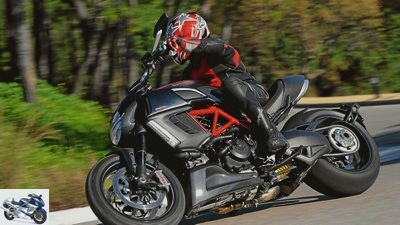
Jahn
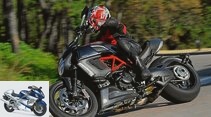
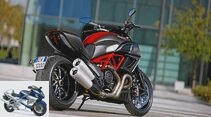
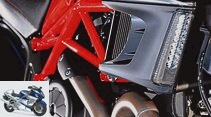
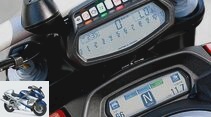
23 pictures
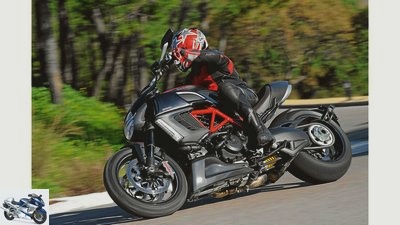
Jahn
1/23
Ducati Diavel: The devil’s roast from Bologna surprised the motorcycle world, its success even Ducati.
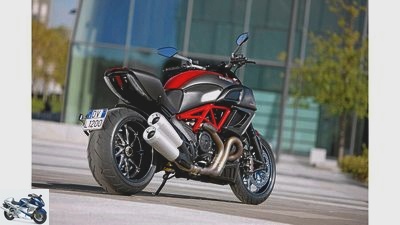
Jahn
2/23
Ducati Diavel from behind.
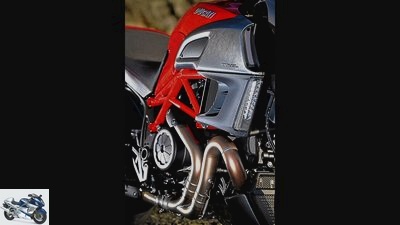
Jahn
3/23
As powerful as everything on the Diavel: manifold pipes with a diameter of 58 millimeters.
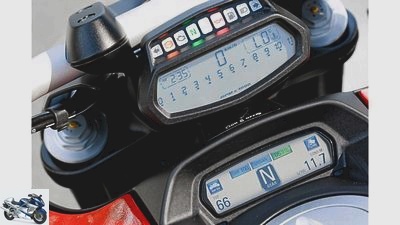
Jahn
4/23
Completely new like many things on the Diavel: Two TFT displays ensure an unparalleled flow of information.
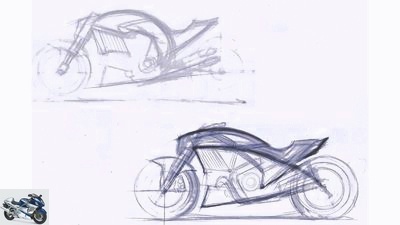
Jahn
5/23
“The Diavel is sexy,” says project manager Giulio Malagoli. From the very first drawings, Ducati relied on a mix of styles and extremes for this motorcycle.
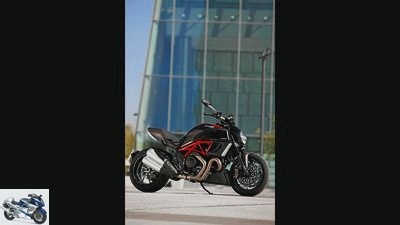
Jahn
6/23
Ducati Diavel.
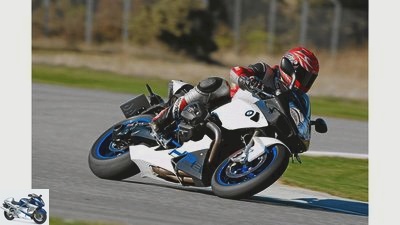
Jahn
7/23
BMW HP2 Sport: Consistency down to the last detail: never before has BMW had such a radical sports motorcycle.
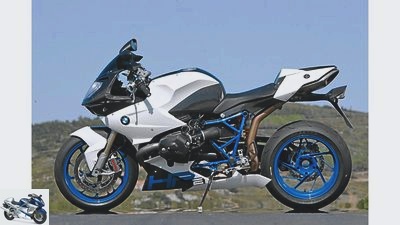
Jahn
8/23
BMW HP2 Sport.
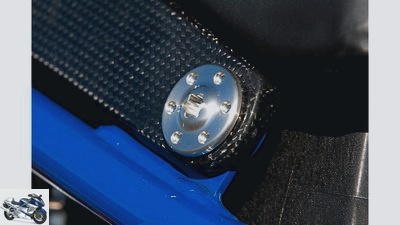
Jahn
9/23
The excellent workmanship of the HP2 Sport is evident on both a large and small scale.
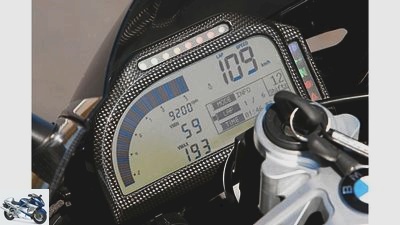
Jahn
10/23
The cockpit exudes a real GP atmosphere. The HP2 Sport looks clearly more delicate than the previously known R 1200 S.
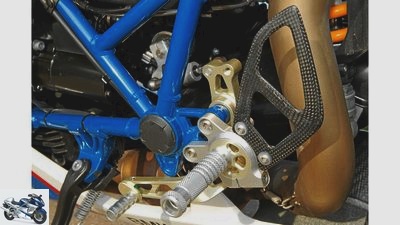
Jahn
11/23
Footrest system (adjustable) of the BMW HP2 Sport.
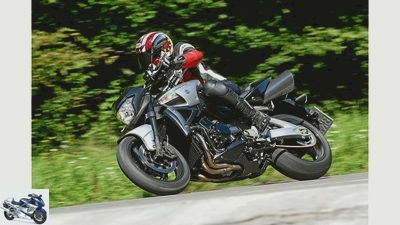
Jahn
12/23
Suzuki B-King: what a colossus! When driving, the B-King impresses with fine manners and good handling.
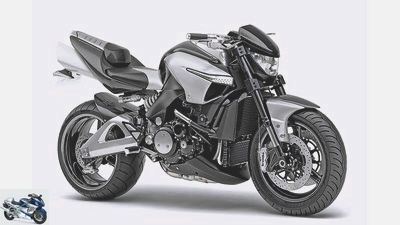
Jahn
13/23
Tokyo Motor Show 2001: The B-King was introduced as a concept bike. It came onto the market in 2007 with slight visual changes.
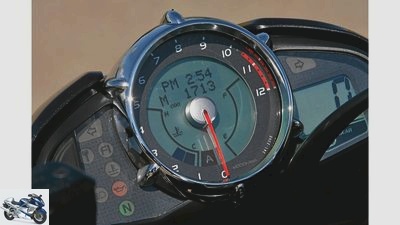
Jahn
14/23
The stylish tachometer with integrated multifunction LCD cost the developers a lot of time and effort.
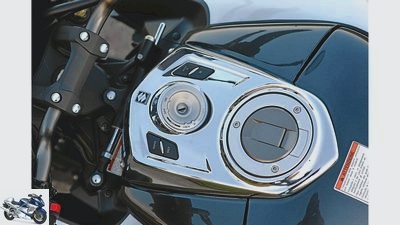
Jahn
15/23
The B-King was supposed to be noble and perfect, the tank fitting is decorated with fine chrome.
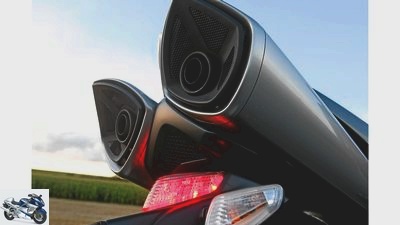
Jahn
16/23
Exhaust of the Suzuki B-King.
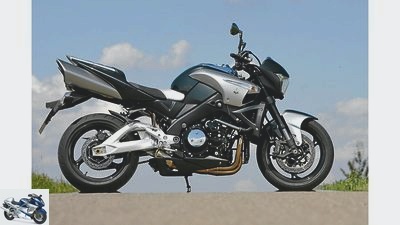
Jahn
17/23
Suzuki B-King.

Jahn
18/23
Yamaha MT-01: In the study, the shock absorber was installed to the left of the engine, the series carries it underneath. Otherwise the differences are marginal.
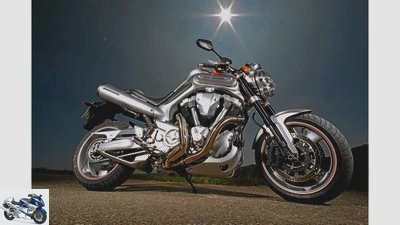
Jahn
19/23
Yamaha MT-01.
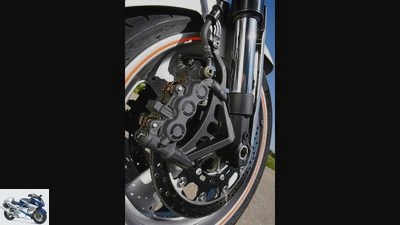
Jahn
20/23
Regardless of whether there are four or six pistons (from 2007) in the fixed calipers, both can brake splendidly.
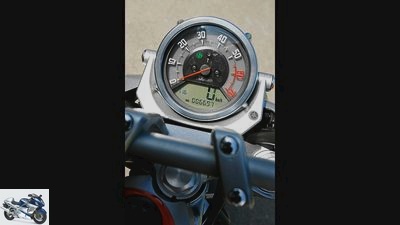
Jahn
21/23
Everything about the MT-01 is huge, including this cool tool for displaying the revs.
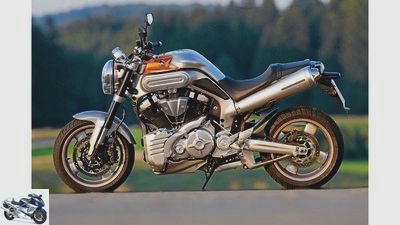
Jahn
22/23
Yamaha MT-01.
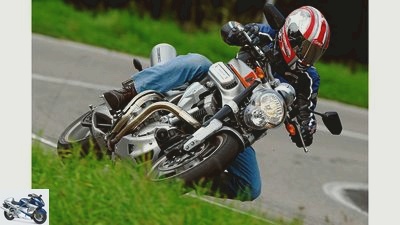
Jahn
23/23
The MT-01 is the right Bollermann – not only, but also for the sloping situations in life.
motorcycles
Unusual motorcycles from Ducati, BMW, Suzuki and Yamaha
Motorcycles that fall out of the ordinary
Unusual motorcycles from Ducati, BMW, Suzuki and Yamaha
Nobody had them on the bill: with the HP2 Sport, the Diavel, the B-King and the MT-01, BMW, Ducati, Suzuki and Yamaha landed real surprise coups. MOTORRAD tells the story of these unusual models and highlights technology and driving behavior.
Stefan Gluck, Gert Thole, Andreas Bildl, Eva Breutel
08/30/2012
That would be something for the next free space in the garage: a motorcycle that is absolutely unprecedented, impresses with extraordinary dynamism and with its striking exterior causes a sensation anytime and anywhere. Such motorcycles actually exist, and not that few at all. We will report on four of them on the following pages, with a focus on their driving behavior, their performance, their character, but also their development history.
Buy complete article
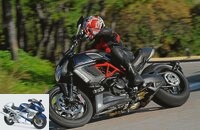
Motorcycles that fall out of the ordinary
Unusual motorcycles from Ducati, BMW, Suzuki and Yamaha
10 pages) as PDF
€ 2.00
Buy now
Sham packs are not among them, all of them are very special machines that stand out from the usual. BMW’s HP2 Sport is no longer built, but still deserves attention – especially since their current used prices are not too far removed from the original price at the time. Detailed character studies of other unusual models will follow in the next issue.
Ducati Diavel
Cruiser? Dragster? Street fighter in disguise? Disguised athlete? No idea. The answer to the generic question of the Diavel knows neither MOTORRAD nor manufacturer Ducati herself. A real stroke of luck for the Italians, because the wild mix of different style and technology elements is what makes the power lady so attractive.
At first glance, it goes through as a bodybuilder’s iron: low, well-padded armchair for Schwarzenegger and his friends, upright, comfortable seating position, straight, wide handlebars, plus a whopping 1590 millimeter wheelbase and a 240 mm slipper on the rear wheel. But then the similarities with motorcycles that are similarly trimmed to be muscled come to an end, because the Diavel weighs around 70 kilograms less than the Vmax of Yamaha or the V-Rod from Harley-Davidson. And, even better: it drives very differently. Namely sloping, sporty and lustful around every curve and every bend. Where the colleagues have long been paddling over the asphalt with their pegs from close to the ground, the Diavel swings casually and downright light-footed through winding fields. Despite the huge rear tire, this works without great effort, because thanks to its contour specially developed for this motorcycle, the special Pirelli rolls off better than similarly large rubbers. In addition, the chassis cannot and does not want to deny its origin, which is now in the Ducati sports halls. The 50s Marzocchi fork and the Sachs shock absorber provide good feedback and don’t even hit two people, the brakes come from Brembo’s super sports series and can be optimally dosed, but slow down with real brute force if necessary: thanks to the excellent ABS from Bosch the Diavel stops from 100 km / h after 37.5 meters. When did that ever happen in a cruiser or dragster??
The highly athletic drive goes well with the taut chassis and robust brakes – Ducati has nothing else in its range in this displacement class. It comes from the Multistrada and in the Diavel variant it gets 153 hp from its two cylinders. That is easily enough for a very determined forward thrust and more than enough pressure in each gear. The now legendary Vmax, however, relies on significantly more horses, namely 200, which is why the Diavel loses out when measuring from 0 to 100 km / h. However, only by three tenths of a second, and also mainly because of its comparatively short gear ratio: first gear only reaches 90 km / h and requires a time-consuming shift.
The Ducati wears out this small notch with electronics en masse. Three different driving modes make you either a tamed beast with only 104 hp and early-acting traction control or a low-flying full-power hunter of the country road. However, should anyone have any doubts, the remote control ignition key and the two futuristic-looking displays finally make it clear: This is a state-of-the-art motorcycle that has nothing in common with old-style cruisers apart from certain optical echoes. This also applies to the character, because if you want to cruise comfortably and relax and watch the sunset, you are wrong with the Ducati: Like all reds from Bologna, it is fully dynamic and always wants to be actively moved.
The Diavel leaves no one cold. Some find them brilliant, others mercilessly superfluous. After all, everyone agrees that there has never been a motorcycle like this. Cruiser, dragster, streetfighter, athlete? It doesn’t matter. The Diavel is an exciting and sensational motorcycle that is devilishly fun. Ducati has thus fulfilled its self-imposed task of putting something completely new on its wheels with glamor.
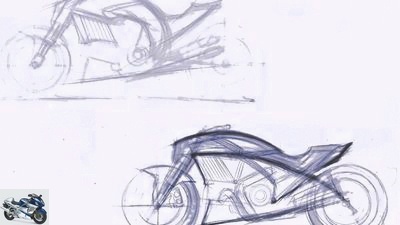
Jahn
“The Diavel is sexy,” says project manager Giulio Malagoli. From the very first drawings, Ducati relied on a mix of styles and extremes for this motorcycle.
History of the Duacti Diavel
Ducati had dared to venture into cruisers or choppers earlier, because Harley-Davidson’s blazing sales figures aroused desires. But they were half-hearted attempts like the mighty 1200 Apollo from 1963 or the Indiana 350 and 750 that tried their luck at the end of the 80s. None of these models had any noteworthy success; as a precaution, the Apollo was not even mass-produced. When the US group TPG took over Ducati at the end of the 20th century, the cruiser issue came up again. This time, however, the designers and engineers did not want and should not copy what already existed, but rather implement a completely new concept. But Ducati was ailing, the managers were afraid of their own courage. So it remained with drafts that at least anticipated some elements of the Diavel.
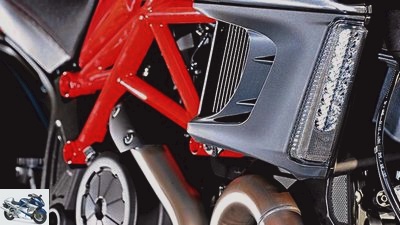
Jahn
As powerful as everything on the Diavel: manifold pipes with a diameter of 58 millimeters.
Only when Ducati successfully ventured out of the sports niche with motorcycles like the Multistrada did the developers blow the dust off these drawings. The engineer Giulio Malagoli took over the management of the initially nameless project, who describes the key points as follows: “Long and low as a cruiser, but sporty and strong. And above all sexy. “Sexy? “Yes, sexy. Anyone looking at the Diavel should feel like touching it. That is why we developed the unusual shapes and surfaces such as the steel tank with particular care. ”An extremely wide rear tire was chosen as an eye-catcher. Malagoli and his crew experimented with off-the-shelf models, but were not satisfied with the results, which is why they worked with Pirelli to develop a new 240 for a 17-inch bike – with a contour not dissimilar to that of a MotoGP tire. “The most important component was thus determined. We practically built the motorcycle around the tire. “
Extreme became part of the program, from the thick manifolds to the huge exhaust bags to the aggressively crouched front. The technology could not be inferior, power in abundance competed with electronics. When the right name was found with Diavel, the Bolognese dialect word for devil, Ducati presented its new one confidently, but secretly with some apprehension – and was surprised by the enormous response itself. In the first five months until mid-2011, 5,000 units were sold, 600 of them in Germany alone. In 2012 the run on the Diavel weakened somewhat, but it remains a safe bet for the Italians. “We were brave,” says Ducati boss Del Torchio. “And it was worth it.”
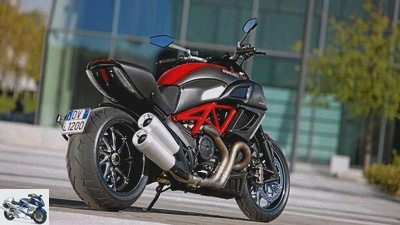
Jahn
Ducati Diavel from behind.
Technical specifications
Two-cylinder 90-degree V-engine, displacement 1198 cm³, output 112.7 kW (153 hp) at 9500 / min, torque 128 Nm at 8000 / min, tubular steel frame, six-speed gearbox, chain drive, single-sided swing arm, upside-down Fork, Ø 50 mm, suspension strut, double disc brake at the front, Ø 320 mm, disc brake at the rear, Ø 265 mm, tank capacity 17 liters, weight with a full tank 241 kg, price: 18,250 euros.
BMW HP2 Sport
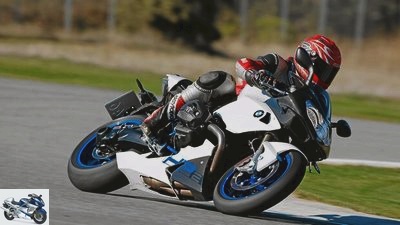
Jahn
BMW HP2 Sport: Consistency down to the last detail: never before has BMW had such a radical sports motorcycle.
Even those familiar with the subject were amazed when the HP2 Sport was presented in 2008. Of course, Boxer BMWs had been romping around the racetracks in the Boxer Cup for a few years as a supporting program for the motorcycle world championship, but those were bravely pimped-up R 1200 S. That was spectacular, but sometimes seemed slightly quirky.
Such a consistent commitment to sport, as represented by the HP2 Sport, had never before been seen from BMW. Heated grips, pillion seat, luggage rack? Forget it. For this, lovingly and nobly made down to the last detail, equipped with everything a racing driver could wish for. A mighty silencer hung under the self-supporting carbon rear, plus forged wheels and a 2D dashboard in GP style. And carbon parts without end. From the cockpit to the rear light carrier. Milled, adjustable racing pegs and handlebar stubs, Ohlins chassis and powerful Brembo monobloc anchors did not allow any misunderstandings to arise visually. The HP2 was serious about the sport.
She had lost twelve kilograms compared to an R 1200 S. And you can feel that. No BMW has turned so resolutely on the circuit before. The crisp, tightly tuned chassis ensures that steering commands are implemented without further ado. And it also enables jagged changes of direction in chicanes without the well-known crumpling of previous “sports” boxers. Restlessness in the framework? Barely available. Not even if the carbon caps of the cylinder heads rasp gently on the asphalt in an inclined position. Consistent hanging-off in order to increase the lean angle should therefore be part of the pilot’s repertoire despite the already higher built-in engine. Because despite everything, the HP2 Sport is still a bit removed from modern sports files. This is ensured by the cardan shaft, longitudinal crankshaft and the tele-lever front suspension.
But that doesn’t change anything about the experience value of the HP2 Sport. Your engine is a show. A boxer from Munich never turned higher, he was never stronger. At the time, the specimen in the top test (9/2011) had a juicy 133 hp. A whole new dimension that some dogged racing boxers did not venture into. This was made possible primarily by new cylinder heads in which two horizontally positioned camshafts controlled four radially arranged valves and let the boxer breathe in through milled channels.
It should be mentioned here that it runs smoothly from 2000 rpm and pushes forward reliably. But it becomes really fun with it from 6000 rpm when the exhaust flap allows full passage and the flat twin announces with a powerful trumpet that it feels most comfortable in the upper speed range.
A pleasure as well as changing gears. Until then, who would have thought that this would one day be said of a boxer BMW. But the automatic gearshift – the first to be installed in series – ensures that the next gear is safely seated under full load. Real racing feeling, even if the shift pattern is conventional and not reversed in racing style. But even demanding racers are reconciled in the braking zone at the latest. Because the effect of the monumental Brembo Monobloc pliers leaves nothing to be desired. And the aggressive late control ABS, which lets the hindquarters dance and become light, shows that she is serious about the sport, the HP2.
It is therefore painful that it had to cede after only four years of construction. Because a BMW, especially a boxer model, with this finish is still unique today. But the role of the top athlete had already been taken over by the S 1000 RR by then, and no boxer could even come close to keeping up with its excessive power.
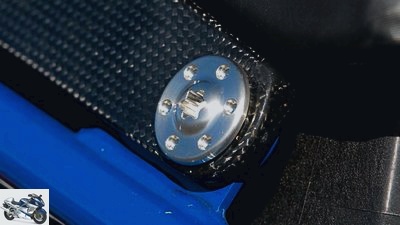
Jahn
The excellent workmanship of the HP2 Sport is evident on both a large and small scale.
History of the BMW HP2 Sport
No Sports – that seemed to be the directive for the BMW model range so far. Even though the HP2 Enduro and 2007 the HP2 Megamoto had already tied the first tender ties to the sports sector in 2006 – and so cautiously indicated the sporty change of heart at BMW. But her sporty attitude didn’t come across as really believable.
And then came the HP2 Sport. Crazy idea, bold daring? Neither, says BMW. The HP2 models (high performance, two-cylinder boxer) represented a separate category in the model range, similar to the M series in the BMW four-wheeler group. In this respect, the sport was only the logical continuation of this series. However, the decision-making process, of which the following anecdote has been handed down, did not go entirely smoothly. Before the start of the project, the development team, which included Gerhard Lindner (product manager) and Rainer Baumel (project manager), two former MO-TORRAD editors, had created an equipment wish list for the HP2 Sport after extensive test drives with competing machines. And this must-have list was long and expensive.
Of course, Baumel and Lindner, in suits and ties open to the decision-making committee, flew out again on edge. Too expensive, so the announcement of the board of directors. A new date in two weeks, then please with savings suggestions. To whom Baumel and Lindner did not appear. From Dr. Herbert Diess, Head of BMW Motorrad, called by phone, both came casually in jeans and sat down without a word. The short answer to the question of what you have prepared: “Nothing.” When asked why not, both of them answered that nothing could be left out of the HP2 Sport. Either you build it like that or you don’t build it at all. The HP2 Sport was built. 2259 times.
What later turned out to be a stroke of luck. Because the double cam heads required for the desired performance formed the basis for the entire next generation of dohc heads. In this respect, the high development costs of this construction are likely to have paid off retrospectively.
575 copies of the naked 21,600 euro darling found enthusiasts in Germany, 308 of which are still rolling on the streets. Excellent used cars are traded at the new price even today within sight. Occasionally, new copies even appear today in the relevant Internet exchanges.
This means that the HP2 Sport not only holds a special position within the model range, but also in terms of value retention. With which the step to the sought-after collector’s item is not far.
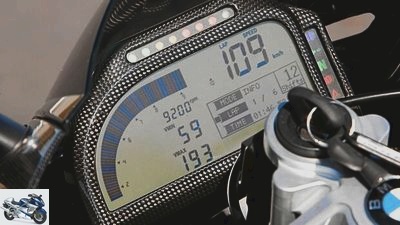
Jahn
The cockpit exudes a real GP atmosphere. The HP2 Sport looks clearly more delicate than the previously known R 1200 S.
Technical specifications
Two-cylinder boxer engine, displacement 1170 cm³, power 97.8 kW (133 PS) at 8750 / min, torque 115 Nm at 6000 / min, tubular steel frame, six-speed gearbox, cardan drive, single-sided swing arm, trailing arm telescopic fork, Ø 41 mm, strut, double disc brake front, Ø 320 mm, rear disc brake, Ø 265 mm, tank capacity 16 liters, weight with a full tank 206 kg, price: 21,600 euros.
Suzuki B-King
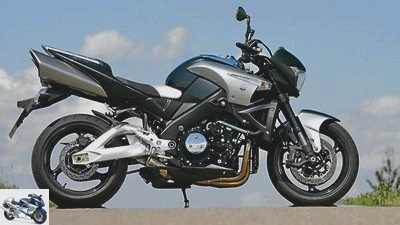
Jahn
Suzuki B-King.
You stand in front of the motorcycle, wondering if this thing can really drive? Not sure if the product planners and designers smoked a few hallucinogenic substances too much? But somehow the bike still turns you on? Then you’re probably standing in front of a Suzuki B-King. The dimensions, which are particularly unique in terms of width, have a frightening, martial effect on the less trained driver, and for some self-proclaimed aesthetes simply artificially oversized. Well, in the many years of development, those responsible at Suzuki will have certainly thought about the numerous unusual but fine details. Because after all, she wanted B-King become the flagship of the manufacturer. More about this in the box on the right.
You get on, start the engine, and after a few meters your facial expression involuntarily turns into a big grin. Because the thing is a rocket – and one with 184 Hayabusa horsepower. The inner workings of the B-King are dominated by the 1340 cubic centimeter in-line four-cylinder, which is also incorporated into the 2008 version of the Hayabusa speed bike. 184 hp in a naked bike – you could think of that as sheer madness. Maybe it is, but a wonderful one!
As soon as you have driven out of the underground car park into the urban jungle, the B-King will attract everyone’s attention. Older women flinch, looking in disbelief that such a grim motorcycle / driver unit actually stops properly at the zebra crossing. Yes, undoubtedly the B-King provokes reactions, stands out for its brute masculinity, its openly displayed potency.
And of course thanks to their underseat rear silencers, which dominate the rear of the motorcycle. It is well known that the two triangular plastic pipes are only cladding and insulation protection of the single silencer hidden underneath, which is not exactly nice to look at. Some find the prominent exhaust pipes pubescent, others celebrate them as the unique selling point of a ruthless weapon. Many swap them for conventional underseat accessory dampers.
Despite its brutal appearance, the B-King is surprisingly easy to drive at first, almost tame to the touch. You roll through the city, the engine hangs neatly on the gas, and in the partial load range you get down to business very gently. But you can already feel that the motorcycle wants more than short sprints to the next set of traffic lights. So quickly out of the city, into the country road swing.
You step down two gears, finally full throttle. Then you know: this is the revelation! Thanks to the long wheelbase, perhaps also thanks to the considerable mass, the front wheel, contrary to expectations, does not hit you in the face, it always remains toothed with the asphalt. The motorcycle pushes, pushes, and beats you towards the horizon. It just doesn’t stop, this is the cannonball ride. Regardless of whether from low or medium speeds, the B-King shoots ahead with fat torque. The 200 mm rear tire does a great job, always keeping the load on course. That is the successful madness on two wheels.
The Suzi engineers have also shown a good hand with chassis geometry and suspension setup. The upside-down fork is responsive, the shock absorber proves to be a great combination of comfort and sporty flavor. The motorcycle can be steered into the curve almost playfully and always stays true to the targeted line. At least as long as there are no longitudinal grooves or bouncy castle-like road conditions. Then the 259 kilogram B-King gets starry airs. Catching is easy with the great Nissin stoppers thanks to good feedback, the current versions also have an ABS.
Finally you get off, wonder what you’ve experienced and know: this is the king. This is how it rules on two wheels.
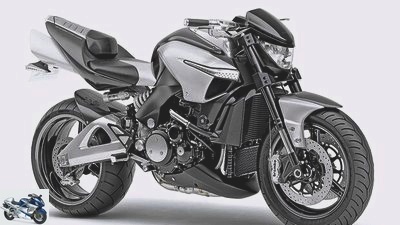
Jahn
Tokyo Motor Show 2001: The B-King was introduced as a concept bike. It came onto the market in 2007 with slight visual changes.
History of the Suzuki B-King
It happened at the Tokyo Motor Show in autumn 2001: Suzuki presented a martial-looking naked bike with a supercharged four-cylinder, which came from the then current speed bike Hayabusa. Suzuki called this study B-King, which at the time no one thought of putting it into practice. The concept was too insane, the design too extreme. But the B-King hit like a bomb and was then passed around at many trade fairs and exhibitions. A real hype set in with the unanimous tenor: build, and that is exactly how it is.
So in 2004 Suzuki hired Satoshi Isokari to put the project into series production. He wasn’t particularly enthusiastic. Because the study just seemed too far removed from the feasible, after all, that was not an issue during the conception. The Isokari team therefore made some changes, both technically and optically. But the reaction to the internal presentation of the first three-dimensional model was clear: “This is no longer a B-King.”
A year of design debate followed, in which the company reoriented itself. Then the Suzuki boardroom ordered a second attempt, which should stay closer to the study. A lengthy process developed in which technical and optical specifications were discussed extensively. The successful implementation of the B-King was important to everyone involved, so internally conventions were broken. Suddenly groups of people were discussing with each other who otherwise worked largely independently in their field of activity.
After all, the B-King was supposed to be an extraordinary motorcycle, a kind of flagship for the manufacturer. This includes a perfect finish, for example the tank fitting framed with plenty of chrome. If the designers were very well aware that there would be no need to integrate a chrome application at precisely this point, they simply said: “It looks cool.”
The two key technicians Yoshinari Ninomiya and Masashi Akagi also wanted a bike that would deserve the name “King”. The 2001 study, which of course was not functional, aimed at a whopping 250 hp with supercharger technology. Of course, charging was out of the question for series production. But Ninomiya and Akagi agreed that the B-King should overshadow everything known in its segment. The Hayabusa engine would guarantee that in any case, especially since the revised 2008 version of the four-cylinder with 1340 cm3 was already being developed at the same time.
After all the hype, it was to be expected that the B-King would be a sales success. However, the demand in this country was not particularly high. By June 2012, a total of 2,000 copies had been sold in Germany. It was probably the extreme design that stood in the way of further dissemination. Extroverted design can inspire, no question about it. But it takes a healthy dose of self-confidence to take to the streets with this macho bike.
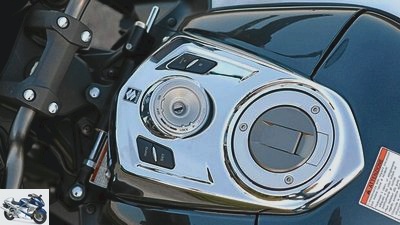
Jahn
The B-King was supposed to be noble and perfect, the tank fitting is decorated with fine chrome.
Technical specifications
Four-cylinder in-line engine, displacement 1340 cm³, output 135 kW (184 PS) at 9500 / min, torque 146 Nm at 7200 / min, aluminum bridge frame, six-speed gearbox, chain drive, aluminum two-arm swing arm, upside-down fork, Ø 43 mm, Central spring strut with lever system, double disc brake at the front, Ø 310 mm, disc brake at the rear, Ø 260 mm, tank capacity 16.5 liters, weight with a full tank 259 kg, price plus ancillary costs (2011): 13,290 euros.
Yamaha MT-01
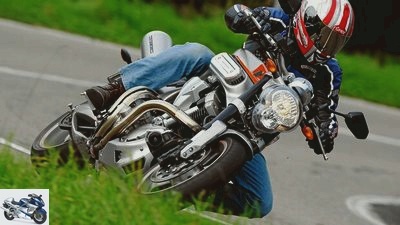
Jahn
The MT-01 is the right Bollermann – not only, but also for the sloping situations in life.
The good things still exist! It’s a shame that this slogan has been borne out by the luxury furniture store Manufactum. This statement also fits Yamaha’s MT-01 just as well as the lovingly made, wonderfully superfluous and, last but not least, very self-confidently priced noble nippy parts of the favorite outfitter of the upscale “Schoner Wohnen” group, which is often reminiscent of the supposedly good old days.
This rough, albeit not uncouth, but rather lovingly detailed block of motorcycle awakens memories of the time when a motorcycle was not a plastic-wrapped collection of sensors, servomotors and other high-tech or shamefully hidden profane technology, but essentially made up of one Engine and two wheels consisted.
What the MT-01 what makes a mighty beast is of course its air-cooled V2 engine. A bore of 97 millimeters and a stroke of 113 millimeters result in a (SC) stroke volume of a full 1670 centimeters in cubic. It goes without saying that with such a configuration there is no fast-moving result: at just 4750 revolutions, the engine, borrowed from the cruiser Road Star Warrior, which has been heavily redesigned and reduced by a full 20 kilograms, delivers a modest 90 hp according to today’s understanding. But this is only half the story: as soon as the crankshaft turns, it delivers more than 100 Nm to the five-speed gearbox. The peak is a mighty 150 Nm, which is already applied at 3750 revolutions.
The whole thing is already accompanied by the original exhaust system from a deep-bass thump that goes through the core. Passengers, on the other hand, quickly feel the MT-01 definition of hot pants. The popular Akrapovic sound transducers, offered by Yamaha as original accessories, weave a soundscape that doesn’t have to shy away from comparison with the famous trumpets from Jericho.
But regardless of the archaic expressions of life, the V2 is definitely up to date. And that in spite of the optics, the rumors make it seem plausible that when designing the cylinders, Yamaha was inspired by old aircraft engines, and stone-age technical attributes such as lower camshafts, bumpers, rocker arms. Flaps ensure variable conditions in both the supply and disposal tract, with injection nozzles in between with twelve instead of the usual four holes to ensure that the fuel is distributed particularly finely. Delicately moved, around five and a half liters of fuel are enough to caress your soul for 100 kilometers.
The die-cast aluminum frame, which is hardly recognizable as such, is definitely up-to-date. The geometry corresponds to current knowledge. At the front and rear end there are fully adjustable and, in their basic configuration, quite stiff spring elements. The design of the swing arm is based on the R1 sports car, and the six-piston brake calipers are even made by him. Like the brake pump, they are radial in shape.
Nevertheless, it is a surprise how quickly and neutrally the MT-01 can be shooed even over the smallest and undulating streets, despite its almost 270 kilograms live weight and the fat 190 mm rear tire. The low speed level – it is usually between 2000 and a maximum of 3500 tours – always gives the impression of lower speeds than actually applied.
Who, besides those who love the macho look, can this Yamaha be recommended now? Well, there are curve-addicted cruiser friends, sporty speed phobics and friends of the exhaust sound limbo (How low can you go?) Who say: In fact, the good things still exist. You can call this your own for 13,495 euros. It is not at Manufactum, but at the friendly Yamaha dealer.
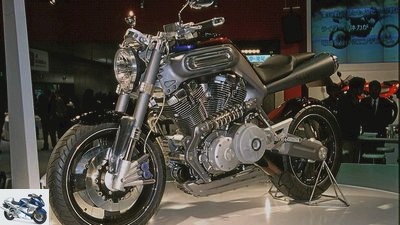
Jahn
Yamaha MT-01: In the study, the shock absorber was installed to the left of the engine, the series carries it underneath. Otherwise the differences are marginal.
History of the Yamaha MT-01
When the MT-01 study was presented at the Yamaha stand at the Tokyo Motor Show in 1999, there was a murmur among experts. In addition to her, the rest of the model range, including the R7 models, which were certainly not manufactured according to marketing strategy considerations, or the steering knuckle-steered GTS 1000, looked like mundane bread-and-butter motorcycles, which of course also existed with the Virago family or the good Diversion tourers. But the combination of a huge, but rather low-performance, long-stroke, air-cooled and, on top of that, a cruiser-borrowed V2 engine with a sporty chassis and driving ergonomics, which had not existed on this side of small screwdriver booths until then.
The then Yamaha President Takeshi Hasegawa announced quite un-Japanese that he wanted to provoke with the MT-01. They want to hit the heart of the clientele, not the brain. Because that had its problems with the study. Cruiser engine, athlete chassis, what’s the point? But do it. As we know today, it is exactly this combination of the casually unexcited tractor drive and a chassis that does not just want to drive straight ahead, as is typical of cruisers. This is what makes the MT-01 so attractive.
As early as 1999, an R1 produced a whopping 150 hp, too much to be able to implement on this side of the racetrack. And in order to offer an alternative to customers who did not want to get used to the faster-higher-further treadmill, the MT-01 developers made Kodo their philosophy. Kodo is Japanese and means something like heartbeat or pulsation. And by the way, it is a style of music in which large, very large and extremely large drums are worked to the edge of ecstasy. This musical experience is not only audible, but also palpable. Anyone who enters Kodo as a search term on Youtube, then zaps through the hit list and then drives an MT-01, can confirm: the specification has been implemented.
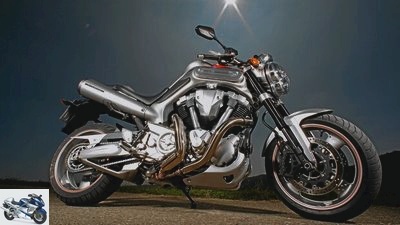
Jahn
Yamaha MT-01.
In any case, the response to the study was so great that the Yamaha superiors decided to build the MT-01 in series. In 2005 the commercial version was available from dealers. Compared to the study, very little has changed: the most striking thing is the shock absorber, which no longer works to the left of the cylinders, but below the engine. The rear wheel, which in the study carried the chain drive and brake disc on the same side, gave way to a conventional, spatially separated solution; the swing arm and triple clamps were designed differently in order to be able to produce them more cost-effectively. Last but not least, the die-cast aluminum frame was given a front girder. The martial macho design, however, remained.
But as it is in life: there are often worlds between what you think is super cool and what you buy. Some find a Chrysler 300C Touring great, but the Passat station wagon is still bought. The MT-01 is similar. In the first year it found a solid 1133 buyers in Germany, in the second 817, after which things went rapidly downhill. In 2011 there were fewer than 100 new buyers. But what makes them even more desirable for the true fan.
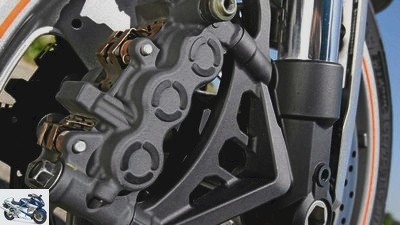
Jahn
Regardless of whether there are four or six pistons (from 2007) in the fixed calipers, both can brake splendidly.
Technical specifications
Two-cylinder V-engine, displacement 1670 cm³, output 66 kW (90 PS) at 4750 / min, torque 150 Nm at 3750 / min, tubular frame made of die-cast aluminum, five-speed gearbox, chain drive, two-arm swing arm, upside-down fork, Ø 43 mm, suspension strut, double disc brake at the front, Ø 320 mm, disc brake at the rear, Ø 267 mm, tank capacity 15 liters, weight with a full tank 267 kg, price: 13,495 euros.
Related articles
-
Comparison test between Suzuki DL 1000 V-Strom and Yamaha TDM 900
Artist motorcycles Comparison test between Suzuki DL 1000 V-Strom and Yamaha TDM 900 Comparison test between Suzuki DL 1000 V-Strom and Yamaha TDM 900…
-
On the move: 250cc from Kawasaki, Suzuki and Yamaha
Jahn 45 pictures Jahn 1/45 Jahn 2/45 Reminisce: For many, a 250cc two-stroke was the first real motorcycle in the 70s. Jahn 3/45 Jahn 4/45 Jahn 5/45 Jahn…
-
Comparison test BMW K 1300 R, Buell 1125 CR, Suzuki B-King, Yamaha Vmax
K 37 pictures Yamaha 1/37 First look at the device from all sides… Yamaha 2/37 Yamaha 3/37 Yamaha 4/37 Yamaha 5/37 Yamaha 6/37 Yamaha 7/37 What is…
-
Ducati Diavel, Yamaha Vmax and CR&S DUU in the test
Gargolov 18th pictures Gargolov 1/18 Posing made easy. With the CR&S DUU, Yamaha Vmax or Ducati Diavel you are an attraction everywhere. Gargolov 2/18…
-
Comparison test: Honda CBF 1000 Silverline, Suzuki Bandit 1250 S, Yamaha FZ1 Fazer
Jahn 22nd pictures Honda 1/22 Honda CBF 1000 Honda 2/22 Honda CBF 1000 Zdrahal 3/22 Presentation at the fair in Paris. Honda 4/22 Honda CBF 1000 Honda…
-
Middle class bikes from Yamaha, Kawasaki, Suzuki and Honda
fact 27 pictures fact 1/27 Comparison of mid-range motorcycles from Yamaha XJ6 Diversion F, Kawasaki ER-6f, Suzuki GSX 650 F and Honda CBF 600 S. fact…
-
Honda CBF 600 S, Suzuki Bandit 650 S, Yamaha FZ6 Fazer
Rossen Gargolov 17th pictures Suzuki 1/17 Suzuki 2/17 Suzuki 3/17 Suzuki 4/17 Suzuki 5/17 Suzuki 6/17 Suzuki 7/17 Suzuki 8/17 Suzuki 9/17 Suzuki 10/17…
-
Comparison test Kawasaki Versys 650, Suzuki V-Strom 650 and Yamaha Tracer 700
www.factstudio.de 27 pictures www.factstudio.de 1/27 Crossover comparison test with the Kawasaki Versys 650, Suzuki V-Strom 650 and Yamaha Tracer 700….
-
Concept studies: Honda NAS 1000, Aprilia 1000 Blue Marlin, Suzuki B-King, Ducati Multistrada
counselor technology & future Concept studies: Honda NAS 1000, Aprilia 1000 Blue Marlin, Suzuki B-King, Ducati Multistrada Concept studies: Honda NAS…
-
Autumn trip 2014 with the endurance test motorcycles
Jahn 50 pictures Map: MAIRDUMONT / Claudia Werel 1/50 South of the Danube, northeast of Lake Constance: The Allgau is a German picture book landscape!…